Why do so many B2B business owners and CEOs not use buyer personas? Simple: they don’t think they need them. You might think the same. But if you’re reading this you’re at least curious about whether they could save you time and bring in better quality leads.
Perhaps you’ve tried using personas before and found them hard to use. Or you’ve got this far without them, so you’re wondering: why start now? Are they worth the time and effort of developing them?
Spoiler alert: they are. Personas can work for you too, even if you’ve tried using them before and been disappointed, and even if you’re pushed for time. When personas don’t work it’s because they haven’t been developed the right way.
This blog explains how you’ll benefit from buyer personas, the common persona pitfalls you need to avoid – and how to develop your own practical, usable personas that will boost your bottom line.
Why You Need B2B Buyer Personas
Buyer personas are “semi-fictional representations of your ideal customers based on data and research”. You need them because you can use them to attract more high-value visitors to your site. They help you generate high-value leads. They make it more likely you can convert leads into customers. And they help you to retain those customers over time, increasing their customer lifetime value (CLV).
According to HubSpot, using personas can make websites 2-5 times more effective, improve email click-through rates by 14% and conversion rates by 10%, and double the effectiveness of paid ads. When done correctly, personas will also have a positive impact across your teams – including Product, Marketing, Sales, and Customer Success.
So, if personas can have such a great impact, why are so many of them ineffective?
Why Most B2B Buyer Personas Don’t Work
The majority of bad personas reflect assumptions that companies make about their customers, without even speaking to them. This leads to personas that don’t reflect the reality of your customers and show the following weaknesses:
❌ They don’t focus on pain points but just talk about the age of the buyer, where they live, their job, their hobbies, and other information that’s completely irrelevant to getting a sale or building a relationship.
❌ They lack context and don’t relate specific pain points to products or services you offer.
❌ They’re created but never used – either because they are irrelevant, or because the creators don’t bother to share or communicate them to the rest of the business.
❌ They’re never updated. This is typical of personas that people create because they think they need one but don’t know how to use them. Personas that are never revised become less effective over time.
A buyer persona should show the interests, needs and pain points of your customers. This in turn helps you to develop value propositions that resonate with them. From there, you can develop marketing and sales collateral: white papers, blogs, emails, paid ads, and social media messages that they will find relevant and engaging. A persona should also show where your customers get their information and where you can reach them. This helps you generate traffic by targeting your campaigns more effectively.
To develop successful, practical personas, you need a process that your business can follow consistently. Here’s the 7-step process we follow when helping our clients to develop personas from scratch, along with practical examples of buyer persona templates you can use.
Step 1: Build a Persona Team
Having the right people involved in a persona process is critical to its success. Creating effective buyer personas is so important that it’s a mistake to delegate personas to mid-level team members or even to the marketing department alone. You really need senior leadership to take an active role.
Make sure the business, marketing, sales, and customer success leaders are all actively involved in the team. That said, you also need to nominate someone to lead the team, settle disagreements, and drive progress. Ideally this should be someone in the senior leadership team, or someone who has the clear support and delegated authority of senior leaders.
Step 2: Define Your Ideal Customer Profiles (ICPs)
Your Ideal Customer Profiles (ICPs) are hypothetical descriptions of the types of companies that you want to become your customers and therefore target with your marketing activity. ICPs are defined using company attributes such as industry sector, employee numbers, annual revenues, geographical locations, etc.
To draw these up, start with your current customer base:
- Discuss ideal customer profiles vs actual/typical profiles with your sales team.
- Analyse the customers in your CRM system and pick out the common traits: industry sector(s), company size, job titles.
- Research your target market based on these common traits. LinkedIn Sales Navigator is a great place to run some exploratory searches on your target market to identify how many companies share the common or desired traits of your ICPs.
- Review the size and quality of all the deals your organisation has closed within the last 12 – 24 months. Do some types of buyers lead to bigger deals or close faster with a shorter sales cycle?
Having done this research, it should become clear that you have several different segments or ICPs that you want to target. At this point, it’s time to flesh them out. Here’s an example of the Ideal Customer Profile template that we use, and here’s the process we use to fill it out:
ICP Name – give your ICP a meaningful name that will be understood around your business.
Use Case / Primary Goal – describe what this particular ICP aims to achieve with your product or services.
Key Competitors – who are the key competitors for this ICP (note: it’s not always the same competitors across different ICPs).
Market Opportunity – how many of these ICP companies you can sell to.
No. of Employees – how many employees the company has.
Geography – where is this ICP located? You need to decide whether to combine multiple territories into a single ICP. This makes it simpler from a planning perspective but means less geo-personalisation.
Job Titles – which specific jobs within these companies you would actively target to buy your product or service.
Example ICP Accounts – some of your existing customers or prospects who can be referenced as representing this ICP.
Acquisition Priority – which ICPs are likely to bring you the highest fees, close in the shortest time, or offer the best long-term profit potential?
Market Opportunity – how much the total ICP market is worth to you, usually calculated as potential Annual Recurring Revenue x Market Size (number of companies).
Sales Effort / Cycle Time – How hard is it to sell to this ICP? Many companies can sell to both SMEs and large enterprises, but it can be much more difficult to sell to the enterprise. This should factor into your prioritisation.
No. Existing Customers – how many of your current customers fit this ICP? If you have existing reference customers, it should be easier to build out more.
Product/Service Fit – how well the ICP fits your product or service. Be honest; not all ICPs are equal in terms of the value they derive from your product.
Average Annual Recurring Revenue – the average annual fee you can earn from a single customer.
Customer Lifetime Value – and how long customers stay with you, on average.
Other Fit Criteria – finally add any other specific criteria which determine whether this ICP will be a good fit.
Once you’ve completed your list of ICPs you should have a good understanding of the different market segments and how much of a priority they are for your marketing strategy. Now you need to think about the people within the ICPs you would like to engage with. Their job titles will form the basis of your buyer personas.
Step 3: Build out your Ideal Customer Profile Job Titles
Reviewing the long list of ICPs you’ve compiled in the previous step, focus on the job titles of the people within the companies that you want to become customers.
In most B2B sales there’s a committee of people involved in purchasing decisions. Normally this is led by one individual and the others are influencers to the purchase. However, sometimes sign off may be required higher up, so the ultimate decision-maker may not be the buyer. Talk to your sales team to identify the most common buyer committees they come up against, and to establish the key roles in the process. Make notes of any differences between your ICPs.
Hopefully now a picture should be emerging of the likely candidates for your personas and it’s time for possibly the single most important step of all….
Want to ignite your lead generation and drive revenue growth? Explore our Demand Generation services and how we can help your business thrive!
Step 4: Interview Customers and Prospects
At this point, you need to come up with some rough personas for the next couple of stages. Don’t worry, you’ll refine these later. Here are the guidelines we use for devising rough personas:
- Define them by their needs rather than job role or the products you want to sell them.
- Group job roles according to defining need, e.g. refreshing their website, running marketing campaigns, cutting operating costs.
- Get a rough idea of these needs from the people in your Persona Team who interact with customers the most.
- Try to come up with around 3 – 5 buyer personas. This is enough to build targeted messaging around, but not so many that it gets impractical to manage.
Now it’s time to interview your customers, which is what will ensure that your customer personas are relevant, impactful, and usable. Most bad personas fail because they skip this step or do it badly, so take the time to get this right.
Identify 3 - 5 existing customers or prospects that fit each of your rough personas. You’re aiming to interview them for around 30 minutes each. Draft your customer interview questions - here’s our customer interview template that we customise for each of our clients (feel free to take a copy).
Keep an open mind when running the interviews. It’s easy to be influenced by preconceptions within your business about who personas are and what they need. Instead, you should ask open-ended questions and be guided by the interviewees.
The key focus of the interviews is identifying shared or unique persona needs – needs that are relevant to your product or service. Asking open questions gives your interviewees space to answer truthfully and in their language – not the language you’d like them to use. Record all of the interviews and write-ups.
Step 5: Test Your Assumptions
This step is what makes the difference between a really effective persona and one that’s irrelevant to your customers. Share the results of your customer and prospect interviews with your Persona Team. Where customer feedback contradicts any of your previous assumptions, tweak your personas to suit.
Make sure you’ve identified the needs your customers actually have - not the ones you want them to have. Change the language if needed to suit the language of your customers.
Now gather together the stakeholders in the business who interface directly with customers, for example Sales, or Customer Success. Share your updated personas and needs, based on your customer and prospect interviews.
Run a brainstorming session (use our template) where you match the needs to your products or services that can solve them. Expand the needs into ones your customers may not have thought of, so you capture the full spectrum of possible needs.
As you get deeper into the brainstorm, group the needs into logical categories. For each need, identify the pain point – the thing that is currently keeping your persona from meeting their need (sometimes called the challenge). Road test these grouped needs and pain points internally – take them round the business and solicit opinions, to check that where you’ve arrived is logically sound.
Step 6: Map Persona Needs
Needs mapping is a critical part of the persona process. It’s where you expand upon the needs each buyer persona has that are relevant to your product or service.
Take the output from the needs brainstorm and add more detail and definition using a needs mapping template (here’s ours). Fill in the template in the following way:
1. Add the needs groups to the spreadsheet
2. Add each need into the spreadsheet with its associated pain point
3. Add your personas as columns
4. For each need you’ve identified, describe the feature of your product or service that meets that need for the customer
5. Describe the benefit that the pain-relieving feature brings
6. Finally, for all needs select how applicable each need is to each of your personas
That’s it! You’ve now got a set of prioritised customer needs that map to your personas and your product or service.
Remember that if you’re looking to develop content for your personas, you can now use this template to help you brainstorm content topics that speak to the need. This is a great way to identify content topics that address your customers’ pain points directly.
Step 7: Bringing It All Together
You’re almost done. You now have a template that maps needs and pain points to personas that you’ve tested internally and by speaking to your customers and prospects directly. The last step is to make your personas easy to read, easy to understand, and easy to use.
In the slides below, you can see how we present an example persona of an entrepreneurial developer/investor. In the first slide we show them from an ICP perspective, including the various job titles and typical responsibilities they could have.
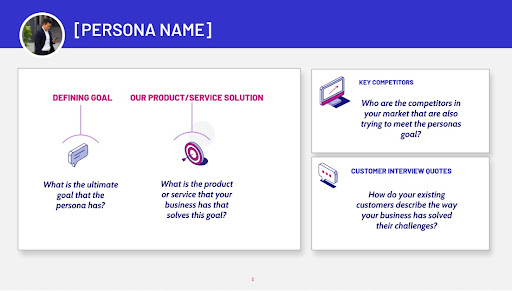
The next slide shows their overarching goal, and a corresponding product or service that can help them reach that goal.
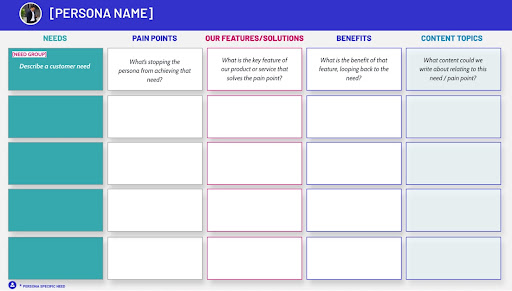
The final slide shows their needs and pain points, bringing to life the needs mapping template in a way that, again, is easy to read and understand at a glance.
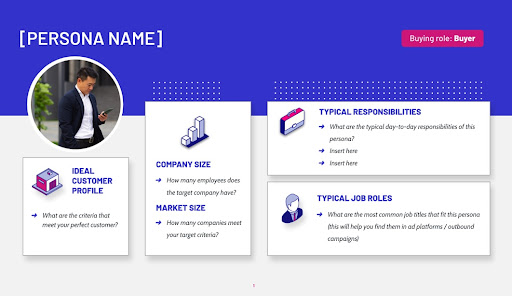
Now you need to share the final buyer personas with everyone in your Persona Team. From there, you want to communicate them to everyone in the business that will have to use them. Ask for feedback in terms of what you could improve regarding their ease of use and simplicity.
Regularly communicate the personas to keep them top of mind. Ask for feedback on how well they are working and any improvements or changes that could be made. This will help ensure they remain relevant and effective.
B2B Buyer Personas: The Foundation For Successful Demand Generation
As you can see, take the time to follow a process methodically and you too can develop B2B buyer personas that your people will actually use. Of course, buyer personas are just one part of what you need to make your demand generation work. Check out our blog on the 5 most common demand generation challenges faced by tech SMEs.
Building a Demand Generation Machine is the best way to create consistent growth in your business. Creating B2B buyer personas is a core component of this - but there is more to it than that.

Are you a B2B company looking to accelerate growth?
Our connected sales, marketing, and HubSpot agency services might be just the ticket. Get in touch for your free growth assessment to find out how you can accelerate business growth today.
.jpg)
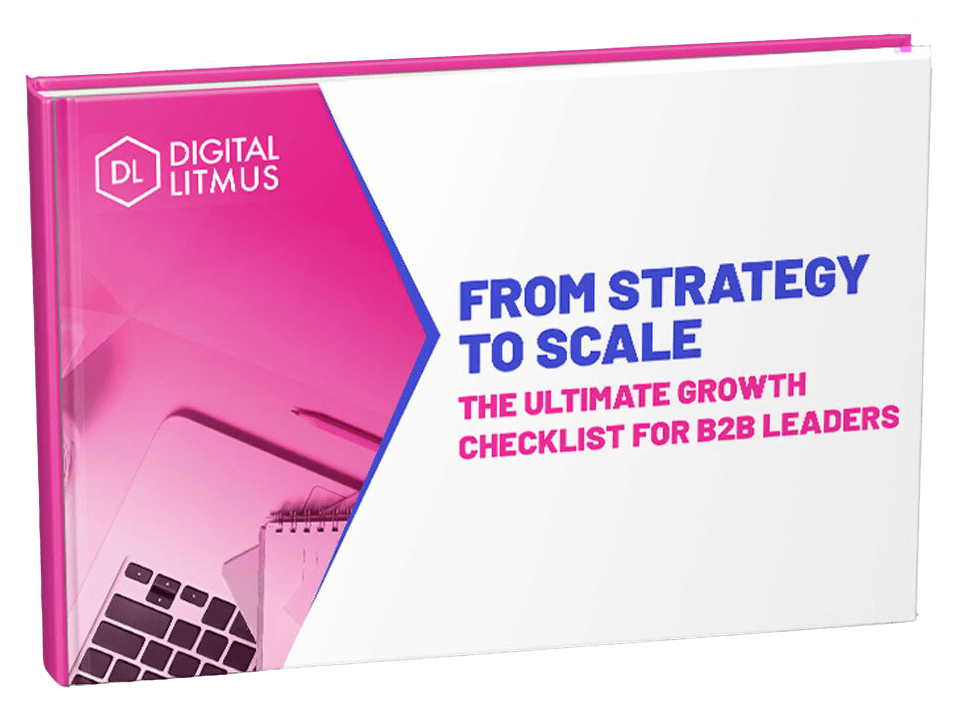
.jpg)
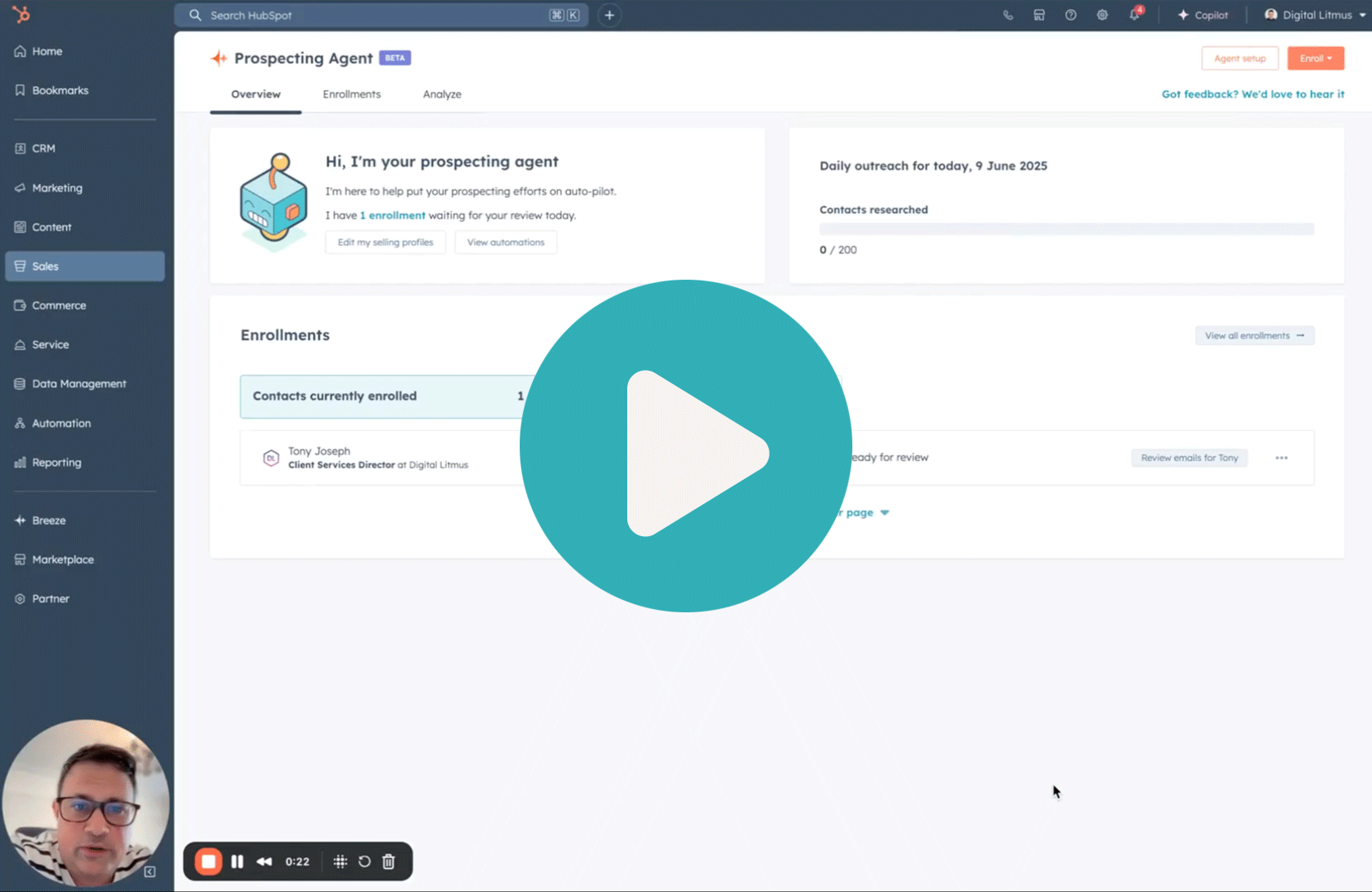

_opt%20(2).jpg)